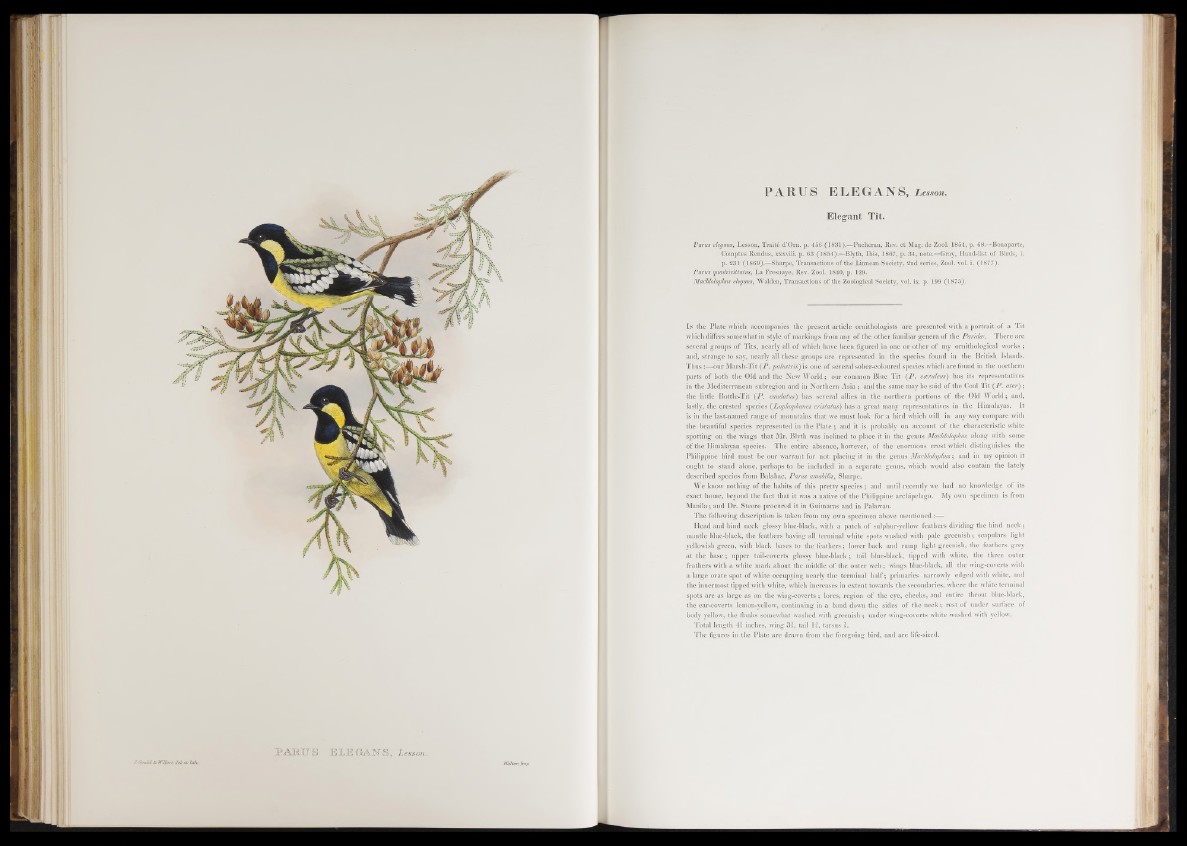
P A R U S E L E G A N S , Lesson.
Elegant Tit.
Parus elegans, Lesson, Traité d’Om. p. 456 (1831) Pucheran, Rev. et Mag. de Zool. 1854, p. 68.—Bonaparte,
Comptes Rendus, xxxviii. p. 63 (1854).—Blyth, Ibis, 1867, p. 34, note.—Gray, Hand-list of Birds, i.
p. 231 (1869).—Sharpe, Transactions of the Linnean Society, 2nd series, Zool. vol. i. (1877).
Parus quadrivittatus, La Fresnaye, Rev. Zool. 1840, p. 129.
Machlolophus elegans, Walden, Transactions of the Zoological Society, vol. ix. p. 199 (1875).
I n the Plate which accompanies the present article ornithologists are presented with a portrait of a Tit
which differs somewhat in style o f markings from any o f the other familiar genera o f the Paridce. There are
several groups of Tits, nearly all of which have been figured in one or other of my ornithological works ;
and, strange to say, nearly all these groups are represented in the species found in the British Islands.
T h u s:—bur M arsh-Tit (JP. palustris) is one of several sober-coloured species which are found in the northern
parts of both the Old and the New World ; our common Blue Tit (P . cceruleus) has its representatives
in the Mediterranean subregion and in Northern Asia ; and the same may be said of the Coal T it (P . ater) ;
the little Bottle-Tit (P . caudatus) has several allies in the northern portions of the Old World; and,
lastly, the crested species (Lophophanes cristatus) has a great many representatives in the Himalayas. It
is in the last-named range o f mountains that we must look for a bird which will in any way compare with
the beautiful species represented in the P la te ; and it is probably on account of the characteristic white
spotting on the wings that Mr. Blyth was inclined to place it in the genus Machloloplm along with some
of the Himalayan species. The entire absence, however, of the enormous crest which distinguishes the
Philippine bird must be our warrant for not placing it in the genus Machlolophus; and in my opinion it
ought to stand alone, perhaps to be included in a separate genus, which would also contain the lately
described species from Balabac, Pams amabilis, Sharpe.
We know nothing o f the habits of this pretty species; and until recently we had no knowledge of its
exact home, beyond the fact that it was a native of the Philippine archipelago. My own specimen is from
Manila; and Dr. Steere procured it in Guimaras and in Palawan.
The following description is taken from my own specimen above mentioned:—
Head and hind neck glossy blue-black, with a patch of sulphur-yellow feathers dividing the hind n eck ;
mantle blue-black, the feathers having all terminal white spots washed with pale greenish; scapulars light
yellowish green, with black bases to the feathers; lower back and rump light greenish, the feathers grey
at the b a se ; upper tail-coverts glossy blue-black; tail blue-black, tipped with white, the three outer
feathers with a white mark about the middle of the outer web; wings blue-black, all the wing-coverts with
a large ovate spot of white occupying nearly the terminal h a lf; primaries narrowly edged with white, and
the innermost tipped with white, which increases in extent towards the secondaries, where the white terminal
spots are as large as on the wing-coverts; lores, region o f the eye, cheeks, and entire throat blue-black,
the ear-coverts lemon-yellow, continuing in a band down the sides of the neck ; rest of under surface of
body yellow, the Hanks somewhat washed with greenish ; under wing-coverts white washed with yellow.
Total length 4 t inches, wing 3f, tail I f, tarsus i .
The figures in the Plate are drawn from the foregoing bird, and are life-sized.